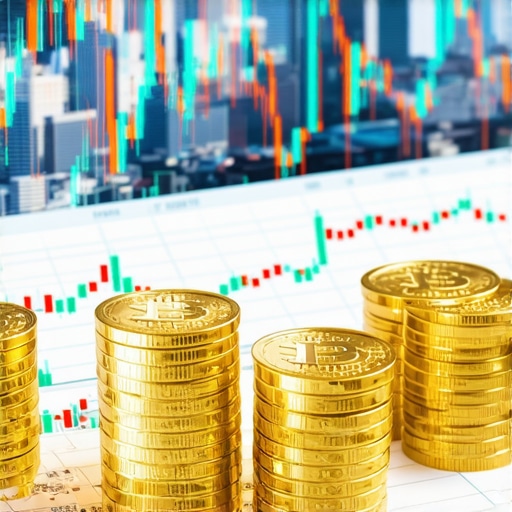The Impact of Central Banks on Gold Prices
Gold has always been considered a safe haven asset, particularly during times of economic uncertainty. One of the most significant influencers of gold prices is central banks, which play a crucial role in the gold market. Central banks hold substantial gold reserves, and their buying or selling activities can lead to notable fluctuations in gold prices. Understanding how these institutions operate can provide valuable insights for investors looking to navigate the complexities of the gold market.
Central Banks and Their Gold Reserves
Central banks maintain gold reserves as part of their monetary policy and financial stability strategies. These reserves can act as a hedge against economic downturns and currency fluctuations. When central banks decide to increase their gold holdings, it often signals confidence in the asset as a store of value. Conversely, when they sell off their gold, it may indicate a shift in strategy or a lack of confidence in gold as a safe investment.
The decisions made by central banks are influenced by various factors, including inflation rates, currency strength, and global economic conditions. For instance, during periods of high inflation, central banks may turn to gold as a protective measure, driving up demand and subsequently increasing prices. Similarly, when they perceive that the economy is stabilizing, they may reduce their gold purchases, leading to potential price declines.
Market Reactions to Central Bank Policies
Market participants often react swiftly to announcements or actions taken by central banks regarding their gold reserves. For example, if a central bank announces a significant increase in its gold purchases, it can lead to a surge in gold prices as traders anticipate higher demand. This reaction can be further amplified by media coverage and market speculation, creating a feedback loop that influences prices further.
Moreover, central banks also play a role in determining interest rates, which can indirectly affect gold prices. Generally, lower interest rates make gold more attractive as an investment, since the opportunity cost of holding non-yielding assets like gold diminishes. On the other hand, rising interest rates can lead to a decrease in gold prices as investors seek higher returns elsewhere.
Global Economic Trends and Central Bank Actions
As central banks navigate through global economic trends, their actions regarding gold can reflect broader economic conditions. For instance, in times of geopolitical uncertainty or financial crises, central banks may increase gold purchases to bolster their reserves and instill confidence in their economic strategies. This can lead to heightened demand for gold, pushing prices upward.
In conclusion, the role of central banks in gold price fluctuations is multifaceted and deeply intertwined with global economic dynamics. Investors looking to understand gold market trends should closely monitor central bank actions and policies, as these can significantly impact gold prices. To further explore how global supply and demand influence gold prices, check out our post on how gold prices are affected by global supply and demand.
Factors Influencing Central Bank Decisions on Gold
The decision-making processes of central banks regarding gold investments are influenced by various factors, including macroeconomic indicators, geopolitical events, and market sentiment. For instance, if inflation rates soar, central banks may view gold as a hedge against currency devaluation. This can lead to increased acquisition of gold reserves, ultimately driving prices higher. Similarly, geopolitical instability often compels central banks to diversify their assets, prompting them to invest in gold as a safe-haven asset.
Gold as a Hedge Against Inflation
Investors often consider gold as a protective measure during inflationary periods. Central banks, recognizing this sentiment, may adjust their gold purchase strategies accordingly. When inflation expectations rise, the demand for gold increases, which can lead to price surges. This dynamic highlights the interconnectedness of central bank policies and gold prices, particularly in an inflationary environment.
Geopolitical Events and Market Reactions
Geopolitical tensions can also play a significant role in influencing central bank actions regarding gold. Events such as trade wars, military conflicts, or diplomatic crises can create uncertainty in the financial markets. In response, central banks may increase their gold reserves to stabilize their economies and reassure investors. This can lead to heightened demand for gold, reflecting the asset’s status as a safe haven during turbulent times. For a deeper understanding of these dynamics, consider reading about gold as a hedge against inflation.
Long-Term Trends in Central Bank Gold Holdings
Over the past decade, there has been a noticeable trend of increasing gold holdings by central banks across the globe. Countries such as China and Russia have significantly ramped up their gold purchases, reflecting a strategic shift towards diversifying their reserves. This growing trend among central banks can have profound implications for gold prices, as increased demand often leads to upward price pressure.
Shifts in Global Economic Power and Gold Demand
The rise of emerging markets has also influenced central bank gold strategies. As countries like India and China continue to grow economically, their demand for gold, both for consumption and investment, has increased. Central banks in these nations may respond by bolstering their gold reserves, further driving demand in the global market. This emphasizes the importance of understanding global economic shifts and their impact on gold prices.
Market Speculation and Central Bank Signals
Market speculation often amplifies the effects of central bank actions on gold prices. Traders closely monitor central bank announcements regarding gold holdings, as these can serve as indicators of future price movements. For instance, if a central bank hints at a potential increase in gold purchases, traders may react by buying gold, anticipating a price increase. This speculative behavior can create volatility in the gold market, leading to rapid price changes.
In conclusion, the interplay between central bank policies and gold prices is complex and influenced by numerous factors. Investors should carefully analyze central bank actions, global economic conditions, and market sentiment, as these elements collectively shape the landscape of gold investment. To gain further insights into effective gold investment strategies, explore our post on effective gold investment strategies for modern investors.
Impact of Central Bank Gold Policies on Market Stability
Central bank decisions regarding gold holdings are crucial not only for their own economies but also for global market stability. When central banks adjust their gold reserves, it can lead to significant fluctuations in gold prices, impacting investors and market participants worldwide. The relationship between central bank actions and market responses highlights the importance of monitoring these institutions’ strategies closely.
The Role of Gold in Economic Resilience
Gold is often seen as a pillar of economic resilience. During periods of financial instability or uncertainty, central banks may prioritize increasing their gold reserves to enhance national economic security. This strategy can reassure investors and stabilize markets, reflecting gold’s reputation as a safe haven. As central banks strengthen their gold holdings, it signals to the market that they are preparing for potential economic downturns, which can influence investor sentiment dramatically.
Gold Purchases as a Signal to Investors
Gold purchases by central banks can serve as a powerful signal to investors. For example, when a major central bank announces an increase in its gold reserves, it can prompt market participants to follow suit, driving demand and prices higher. This behavior underscores the interconnectedness between central bank policies and market dynamics. Investors should pay attention to these signals, considering them as part of a broader investment strategy.
Central Bank Gold Strategies and Their Global Implications
Different central banks adopt varying strategies regarding gold investments, influenced by their unique economic contexts and goals. For instance, emerging economies often view gold as a means to bolster their financial stability and diversify their reserves. In contrast, developed nations may focus on maintaining their gold holdings as a hedge against inflation and economic volatility. Understanding these differences is essential for investors seeking to navigate the gold market effectively.
Emerging Markets and Increased Gold Demand
Countries like India and China have ramped up their gold purchases significantly in recent years. This trend reflects not only increasing domestic demand for gold but also a strategic move to enhance their national reserves. As these nations grow economically, their central banks are likely to continue prioritizing gold, further driving global demand. Investors should be aware of how these dynamics can influence gold prices in the international marketplace.
Developed Nations and Risk Mitigation
In developed nations, central banks often adopt a more cautious approach towards gold investments. They may use gold as a tool for risk mitigation, ensuring their economies remain stable during periods of uncertainty. This strategy can lead to a more measured approach to gold purchases, focusing on maintaining existing reserves rather than aggressive accumulation. Investors should consider these factors when evaluating gold as part of their investment portfolios.
Future Outlook: Central Banks and Gold Investments
The future of gold investments will likely be shaped by the evolving roles of central banks globally. As geopolitical tensions rise and economic uncertainties persist, it is expected that central banks will continue to view gold as a vital asset. Monitoring central bank policies and their implications on gold prices will be crucial for investors aiming to make informed decisions. Staying updated with market trends and central bank strategies can help investors position themselves effectively in the gold market.
In summary, understanding the dynamics of central bank gold policies provides valuable insights into market behavior. By analyzing central bank actions and their influence on gold prices, investors can better navigate the complexities of gold investments and leverage opportunities in this asset class. For more in-depth knowledge on gold investment strategies, explore our post on effective gold investment strategies for modern investors.
Central Banks and Their Evolving Role in Gold Investments
As the global economy undergoes significant shifts, the role of central banks in gold investments is becoming increasingly crucial. The strategic decisions made by these institutions regarding gold reserves not only affect their national economies but also have far-reaching consequences on the global gold market. Understanding these evolving roles can provide investors with critical insights into future market trends.
Geopolitical Factors Influencing Central Bank Gold Strategies
Geopolitical tensions and economic sanctions often compel central banks to reassess their gold holdings. Countries facing economic instability may seek to bolster their gold reserves as a protective measure. For instance, nations under sanctions might increase their gold purchases to mitigate currency risks and safeguard their economies. This trend highlights how geopolitical dynamics can directly influence gold demand and pricing.
Long-term Investment Perspectives
Central banks are increasingly viewing gold as a long-term investment strategy. Unlike other assets that may fluctuate in value, gold has historically retained its worth over time, making it an attractive hedge against inflation. As inflation rates rise globally, central banks are likely to maintain or increase their gold holdings, further driving demand. Investors should monitor these long-term strategies closely, as they can indicate broader market trends.
Understanding the Impact of Gold Demand on Prices
The interplay between central bank policies and gold demand is significant in shaping gold prices. As more central banks commit to increasing their gold reserves, the overall demand for gold in the market tends to rise, leading to potential price increases. This correlation is essential for investors aiming to capitalize on market movements. Understanding how demand influences prices can help investors make informed decisions.
Investing in Gold: A Strategic Approach
For investors, adopting a strategic approach to gold investments requires awareness of central bank activities. By analyzing gold purchase announcements and trends, investors can better position themselves in the market. Keeping an eye on emerging economies and their gold-buying patterns can also provide valuable insights, as these nations continue to play a significant role in global gold demand.
Market Sentiment and Investor Behavior
Market sentiment significantly impacts investor behavior towards gold. When investors perceive that central banks are bullish on gold, it can instigate a surge in buying activity, driving prices even higher. Conversely, if central banks signal a reduction in their gold holdings, it may lead to negative sentiment and lower demand. Therefore, understanding the psychological aspect of the market is crucial for investors looking to navigate gold investments effectively.
Conclusion: Preparing for the Future of Gold Investments
In conclusion, the future of gold investments is intricately linked to the strategies employed by central banks globally. As geopolitical tensions mount and economic uncertainties loom, gold will likely remain a critical asset for these institutions. Investors should stay informed about central bank policies and their broader implications on gold prices. By understanding the dynamics of central bank gold strategies, investors can enhance their decision-making processes and potentially maximize their returns. For more insights on gold investment strategies, consider exploring our guide on effective gold investment strategies for modern investors.
Frequently Asked Questions about Gold Investments
1. Why are central banks increasing their gold reserves?
Central banks are increasing their gold reserves as a strategy to hedge against economic instability and inflation. By holding gold, they aim to protect their national currencies and provide a safeguard during financial crises.
2. How does gold demand influence its price?
Gold demand influences its price through the basic economic principle of supply and demand. When demand increases, particularly from central banks, the price typically rises due to limited supply, especially in times of geopolitical tension or economic uncertainty.
3. Are there risks associated with investing in gold?
Yes, investing in gold carries risks, including price volatility and market demand fluctuations. Additionally, external factors such as changes in government policies or economic downturns can significantly impact gold prices.
4. How can I start investing in gold?
You can start investing in gold by purchasing physical gold, such as bullion or coins, or by investing in gold exchange-traded funds (ETFs) and mutual funds that focus on gold mining companies. Researching and choosing the right investment vehicle is essential for success.
5. What are the benefits of gold as an investment?
The benefits of gold as an investment include its historical ability to retain value, its role as a hedge against inflation, and its low correlation with other asset classes, making it a useful diversification tool in investment portfolios.
6. How do geopolitical tensions affect gold prices?
Geopolitical tensions often lead to increased uncertainty in financial markets, prompting investors to seek safe-haven assets like gold. This surge in demand can drive up gold prices significantly during times of crisis.
7. What is the best time to invest in gold?
The best time to invest in gold is typically during periods of economic uncertainty or rising inflation when demand for gold tends to increase. Monitoring central bank actions and market trends can help identify optimal investment periods.
8. How does inflation impact gold prices?
Inflation generally leads to higher gold prices as investors seek to protect their purchasing power. As inflation rises, central banks may increase their gold reserves, further driving up demand and prices.
9. Can gold investments provide regular income?
Gold investments typically do not provide regular income like dividends or interest. However, investors can benefit from capital appreciation if gold prices rise over time. Some investors choose to trade gold to generate profits in fluctuating markets.
10. How can I stay informed about gold market trends?
To stay informed about gold market trends, consider following financial news outlets, subscribing to gold market analysis reports, and monitoring central bank announcements regarding their gold reserves and policies.
Authority Resources for Gold Investment Insights
For those looking to deepen their understanding of gold investments and market dynamics, here are some trusted resources and literature:
- World Gold Council – Provides comprehensive insights, reports, and data on the gold market.
- Bank for International Settlements – Offers analysis and research on central bank policies and their impact on gold.
- Investopedia – A valuable resource for investment education, including gold and commodities.
- Kitco News – A leading source of precious metals news and market analysis.
- Reuters – Provides up-to-date financial news, including developments in the gold market.
Conclusion: Embracing the Future of Gold Investments
The landscape of gold investments continues to evolve, heavily influenced by the strategic actions of central banks around the world. As economic uncertainties and geopolitical tensions persist, gold remains a critical asset for both central banks and private investors. By understanding the relationships between central bank policies, gold demand, and market trends, investors can make informed decisions that align with their financial goals. Staying abreast of market dynamics and leveraging authoritative resources will enhance your ability to navigate the complexities of gold investments effectively.











The article sheds light on the vital role central banks play in influencing gold prices, especially through their gold reserve strategies. What really piqued my interest is how central banks’ decisions to increase or decrease their gold holdings can act as a signal to the market, shaping investor sentiment and leading to price volatility. From my observation, one challenging aspect for individual investors is timing these market shifts, especially given how quickly speculation and media coverage can amplify reactions. Additionally, the link between central bank policies on interest rates and gold prices offers an interesting dual perspective—it’s not just about gold purchasing but also about broader monetary policies that impact gold’s attractiveness. I’m curious if others have noticed patterns where geopolitical tensions trigger sudden spikes in central bank gold purchases, and how that translates into market moves? Also, considering the varying approaches between emerging economies and developed nations in gold reserve strategies, how might this global divergence impact international investors’ strategies? It feels like keeping an eye on central bank announcements is essential, but integrating that intel with geopolitical and economic trends seems to be the key to navigating gold investments effectively today.